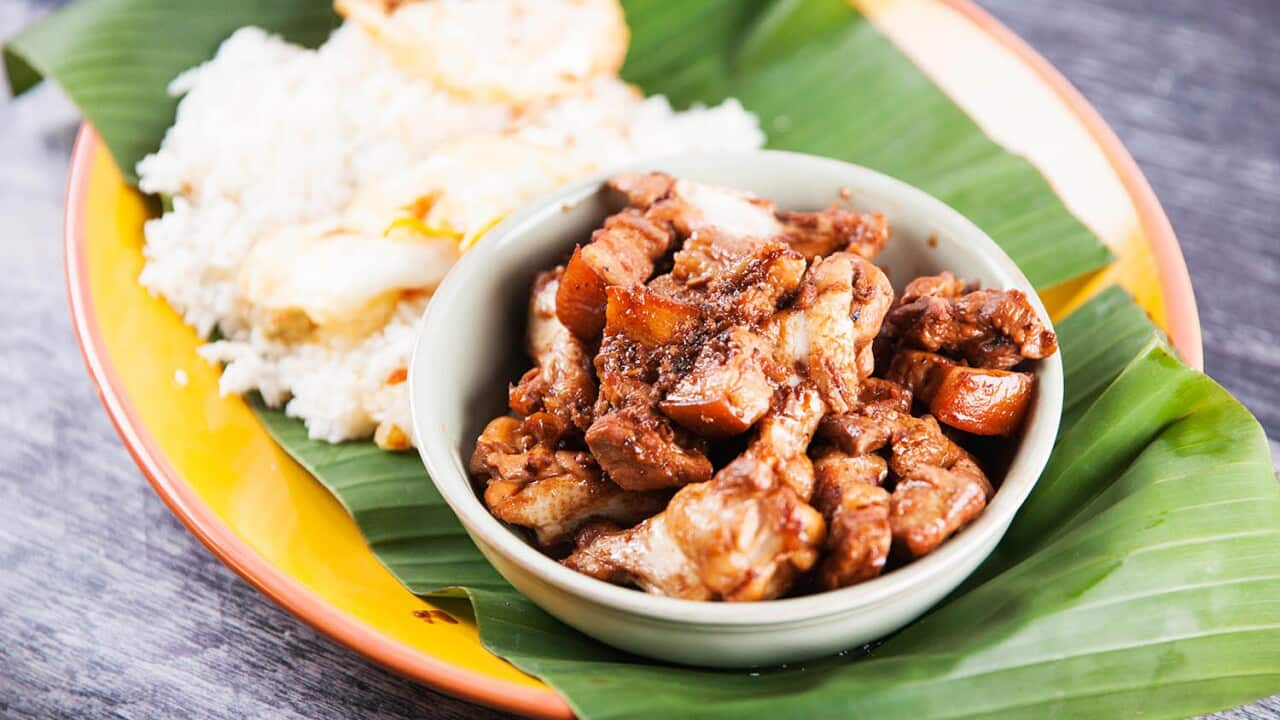Will Mahusay's voice brightens at the mention of Spam. "I love Spam," the owner of gleefully declares.
"It's a guilty pleasure. I have it once a week, and my partner frowns on me because it's not very healthy. But it brings back so many good memories."
Spam, a canned, spiced ham, is an unlikely member of the Filipino culinary canon. It was developed in 1937 by Hormel Foods Corporation, an American company, and fed widely to American GIs around the world during World War II.
These accidental arbiters of taste unwittingly delivered Spam across Europe, Asia and Hawaii. Of Southeast Asian countries, Spam is most popular in the Philippines, where it's been fused with traditional dishes. For example, silog, a breakfast of garlic fried rice, fried egg and meat can become "spamsilog".
Anna Manlulo of the explains, "It started when American bases were established in the Philippines, and they would set up a retail store called a post exchange or PX.
"All these imported foods from the US, like Corn Flakes, Spam, pancake mixes, they were sold by people who had a connection to the base and at the time would be pricey because they weren't common. Spam was kind of a measure of wealth at the time."
Manlulo grew up eating Spam, as did Mahusay who remembers the canned meat as a mark of affluence where he grew up in Cebu in the Central Visayas region.
"Spam was one of those products that was not within reach for the general population," Mahusay says.
"It was very expensive. The average day's wage in Manila in those days was maybe 500 pesos, and a can of Spam cost 400 pesos. So you can see it wasn't affordable. Only the middle class and above could afford it, and it became a luxury item."
Spotting a can of Spam in a family's pantry meant one of two things. "They were middle class and could afford it, or it was pasalubong (a gift or souvenir brought by someone from overseas). Whenever I went back home, I would bring canned food: corned beef, peanut butter, Nutella and Spam.
"It's about the brand name as much as it is about the food."
It's a guilty pleasure. I have it once a week, and my partner frowns on me because it's not very healthy. But it brings back so many good memories.
Today, Mahusay's weekly Spam meal usually involves thinly slicing the meat and pan-frying it until the edges are slightly crisp.
"Sometimes I'll cut it into cubes and then stir fry with scrambled eggs, rice, peas and carrots. You balance out the Spam with vegetables and you've got yourself a meal."
Fides Mae Santos-Arguelles, a founder of , a Melbourne-based collective that promotes Filipino cuisine and culture, also grew up eating Spam.
Spam your next stir-fry

Bitter gourd, egg and Spam stir-fry (goya champuru)
"We had it for breakfast with fresh tomato, sawsawan and then we'd have fried rice. It's nostalgic for me because my parents made it at home," she says.
"Then when we migrated to Australia, we were still establishing ourselves and my parents were working a lot. The tinned foods — Spam, corned beef — were our staples because they're easy to cook, the kids can make them themselves."
Although she doesn't remember the prices of Spam when she was growing up, she agrees that having it in the pantry was a mark of privilege.
"Spam and other tinned foods were staples of balikbayan boxes, the parcels you send from overseas. There's this perception that anything American is superior. If people have Spam, there's a recognition that they have someone supporting the family overseas."
Kristina Náray, her colleague at Entrée Pinays, says that Spam was something eaten in the city, but not in the provinces where her mother's family lived. Although it's a common mistake to conflate the diet of people living in the north, particularly Manila, with Filipino diets in general, there's incredible variety across the archipelago.
"My mum and her friends that grew up in the provinces don't eat Spam or corned beef. People in the city eat that kind of food. It's very normal for us to not eat any meat," she says.
THESE WOMEN ARE MAKING WAVES

Meet the Pinays unleashing a Filipino flavour storm
Spam in the Philippines is well-loved not just for its flavour and versatility, but also for the prestige the American brand carries. The Philippines gained independence from the American's 48-year colonial rule, but left behind was veneration for American culture.
"Filipinos love anything American. They held so much influence," says Mahusay.
Spam might be a hangover from American colonialism, but it's also a symbol of the resilience of a people who rode out centuries of Spanish and American colonial rule, taking what they liked, and making it their own.
ALL ABOUT FILIPINO FOOD

Talking TV, family adobo and Filipino mums with Michelle Vergara Moore









